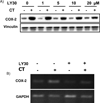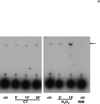LY294002 inhibits glucocorticoid-induced COX-2 gene expression in cardiomyocytes through a phosphatidylinositol 3 kinase-independent mechanism
- PMID: 18657281
- PMCID: PMC4148022
- DOI: 10.1016/j.taap.2008.05.024
LY294002 inhibits glucocorticoid-induced COX-2 gene expression in cardiomyocytes through a phosphatidylinositol 3 kinase-independent mechanism
Abstract
Glucocorticoids induce COX-2 expression in rat cardiomyocytes. While investigating whether phosphatidylinositol 3 kinase (PI3K) plays a role in corticosterone (CT)-induced COX-2, we found that LY294002 (LY29) but not wortmannin (WM) attenuates CT from inducing COX-2 gene expression. Expression of a dominant-negative mutant of p85 subunit of PI3K failed to inhibit CT from inducing COX-2 expression. CT did not activate PI3K/AKT signaling pathway whereas LY29 and WM decreased the activity of PI3K. LY303511 (LY30), a structural analogue and a negative control for PI3K inhibitory activity of LY29, also suppressed COX-2 induction. These data suggest PI3K-independent mechanisms in regulating CT-induced COX-2 expression. LY29 and LY30 do not inhibit glucocorticoid receptor transactivity. Both compounds have been reported to inhibit Casein Kinase 2 activity and modulate potassium and calcium levels independent of PI3K, while LY29 has been reported to inhibit mammalian Target of Rapamycin (mTOR), and DNA-dependent Protein Kinase (DNA-PK). Inhibitor of Casein Kinase 2 (CK2), mTOR or DNA-PK failed to prevent CT from inducing COX-2 expression. Tetraethylammonium (TEA), a potassium channel blocker, and nimodipine, a calcium channel blocker, both attenuated CT from inducing COX-2 gene expression. CT was found to increase intracellular Ca(2+) concentration, which can be inhibited by LY29, TEA or nimodipine. These data suggest a possible role of calcium instead of PI3K in CT-induced COX-2 expression in cardiomyocytes.
Figures














Similar articles
-
LY294002 inhibits monocyte chemoattractant protein-1 expression through a phosphatidylinositol 3-kinase-independent mechanism.FEBS Lett. 2004 Feb 13;559(1-3):141-4. doi: 10.1016/S0014-5793(04)00058-4. FEBS Lett. 2004. PMID: 14960322
-
LY294002 inhibits leukemia cell invasion and migration through early growth response gene 1 induction independent of phosphatidylinositol 3-kinase-Akt pathway.Biochem Biophys Res Commun. 2008 Dec 5;377(1):187-90. doi: 10.1016/j.bbrc.2008.09.094. Epub 2008 Oct 1. Biochem Biophys Res Commun. 2008. PMID: 18831964
-
Enhancement of cytokine-mediated NF-kappaB activation by phosphatidylinositol 3-kinase inhibitors in monocytic cells.Int Immunopharmacol. 2006 Jun;6(6):908-15. doi: 10.1016/j.intimp.2006.01.007. Epub 2006 Feb 3. Int Immunopharmacol. 2006. PMID: 16644476
-
Phosphatidylinositol 3-kinase inhibitors: promising drug candidates for cancer therapy.Cancer Sci. 2008 Sep;99(9):1734-40. doi: 10.1111/j.1349-7006.2008.00891.x. Epub 2008 Jul 4. Cancer Sci. 2008. PMID: 18616528 Free PMC article. Review.
-
Phosphoinositide 3-kinase inhibition in cancer treatment.Expert Opin Investig Drugs. 2001 Jun;10(6):1085-98. doi: 10.1517/13543784.10.6.1085. Expert Opin Investig Drugs. 2001. PMID: 11772237 Review.
Cited by
-
The evidence of HeLa cell apoptosis induced with tetraethylammonium using proteomics and various analytical methods.J Biol Chem. 2014 Jan 24;289(4):2217-29. doi: 10.1074/jbc.M113.515932. Epub 2013 Dec 2. J Biol Chem. 2014. PMID: 24297172 Free PMC article.
-
Influence of biological sex and exercise on murine cardiac metabolism.J Sport Health Sci. 2022 Jul;11(4):479-494. doi: 10.1016/j.jshs.2022.06.001. Epub 2022 Jun 7. J Sport Health Sci. 2022. PMID: 35688382 Free PMC article.
-
Differential Regulation of Bcl-xL Gene Expression by Corticosterone, Progesterone, and Retinoic Acid.J Biochem Mol Toxicol. 2016 Jun;30(6):309-16. doi: 10.1002/jbt.21795. Epub 2016 Feb 25. J Biochem Mol Toxicol. 2016. PMID: 26915917 Free PMC article.
-
Telencephalin protects PAJU cells from amyloid beta protein-induced apoptosis by activating the ezrin/radixin/moesin protein family/phosphatidylinositol-3-kinase/protein kinase B pathway.Neural Regen Res. 2012 Oct 5;7(28):2189-98. doi: 10.3969/j.issn.1673-5374.2012.028.004. Neural Regen Res. 2012. PMID: 25538739 Free PMC article.
-
Peroxisome proliferator-activated receptor gamma ligand-mediated apoptosis of hepatocellular carcinoma cells depends upon modulation of PI3Kinase pathway independent of Akt.J Mol Signal. 2010 Dec 13;5:20. doi: 10.1186/1750-2187-5-20. J Mol Signal. 2010. PMID: 21144036 Free PMC article.
References
-
- Adcock IM, Ito K, Barnes PJ. Glucocorticoids: Effects on Gene Transcription. Proc. Am. Thorac. Soc. 2004;1:247–254. - PubMed
-
- Adderley SR, Fitzgerald DJ. Oxidative Damage of Cardiomyocytes Is Limited by Extracellular Regulated Kinases 1/2-mediated Induction of Cyclooxygenase-2. J. Biol. Chem. 1999;274:5038–5046. - PubMed
-
- Bachelor MA, Cooper SJ, Sikorski ET, Bowden GT. Inhibition of p38 Mitogen-Activated Protein Kinase and Phosphatidylinositol 3-Kinase Decreases UVB-Induced Activator Protein-1 and Cyclooxygenase-2 in a SKH-1 Hairless Mouse Model. Mol. Cancer Res. 2005;3:90–99. - PubMed
Publication types
MeSH terms
Substances
Grants and funding
LinkOut - more resources
Full Text Sources
Medical
Molecular Biology Databases
Research Materials
Miscellaneous

